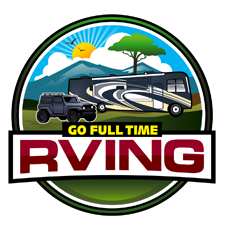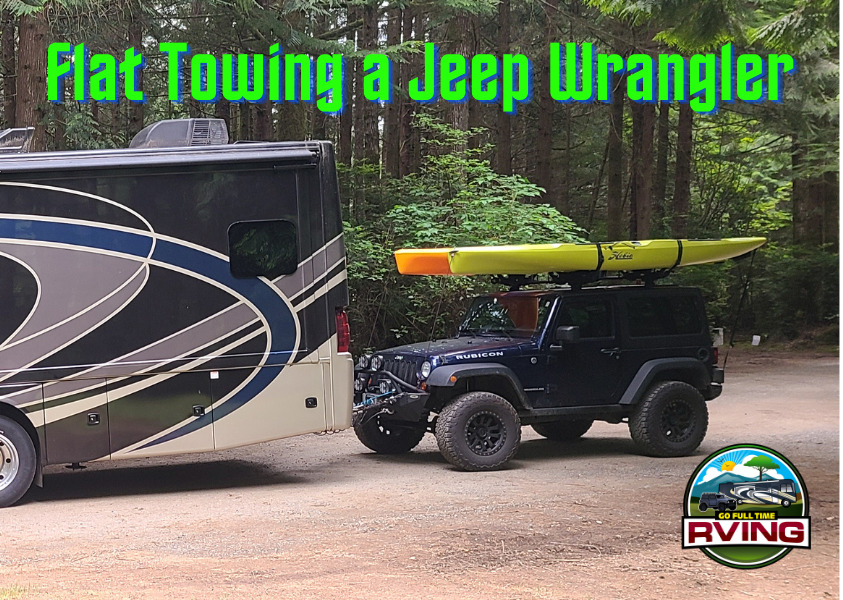There are many choices when thinking about RVing. What type of RV to get is sometimes dependent on the vehicle you have. We already had a paid-off 2013 2 Door Jeep Wrangler Rubicon we didn’t want to necessarily get rid of to buy something that would tow a trailer or 5th wheel we would buy as well. That was one of the main reasons we ended up going with a Class A motorhome for our choice. With that, we would be Flat Towing a Jeep Wrangler behind our motorhome instead of having a truck to pull a trailer.


One of the best Jeep models for flat towing is the Jeep Wrangler. Because of its lightweight features and narrow body, the Wrangler is well-suited for flat towing behind most motorized RVs.
In addition to the Wrangler, other examples of Jeeps that are suitable for flat towing include the Gladiator, all 4×4 models of the Jeep Patriot and Jeep Liberty, certain models of the Jeep Cherokee (only those with ActiveDrive II or 2-speed PTU), and 4-low models of the Jeep Grand Cherokee. While this list is a general guide, the only way to be sure is to check the manual for each particular Jeep.
Most Jeep models are compatible with tow bars from the popular brands, Blue Ox and Roadmaster, which is good because it’s important to find a reliable tow bar with a good track record.
When towing a Jeep Wrangler, avoid bumper-mounted clamp-on tow bars or risk doing severe damage to your Wrangler’s bumper. Of course, you’ll want to choose a tow bar that is not only compatible with your Jeep but also with your RV.
Flat towing our Jeep was one of the most mentally stressful things for me when we started RVing. I would check and double-check everything for fear that I was hooking something up wrong or missing a step that would put our Jeep and the general public in harm’s way if something were to happen.
Before You Flat Tow Your Vehicle
As with all vehicles, Jeep models vary from year to year. Just because your Jeep from the past could be flat-towed, it’s never safe to assume that the same model in a different year can be flat-towed as well. It never hurts to confirm the towing specifications for your Jeep before making a costly mistake.
Check the owner’s manual of your Jeep before flat towing to find out for sure whether or not it is safe to move it this way. The owner’s manual can also cue you into specific tips that will make flat-towing your vehicle more successful.
For instance, some models may require you to leave the keys in the ignition or disconnect certain fuses before flat towing. It’s always better to be safe than sorry, so take the time to educate yourself before setting up a tow.
Base Plate (Maybe)
- Normally the first piece you’re going to need to be able to tow your Jeep is a Base Plate. This is the piece that is mounted
 onto the frame of the vehicle and is a fundamental part of safe vehicle towing.
onto the frame of the vehicle and is a fundamental part of safe vehicle towing.
Some base plates are single, solid bars bolted onto vehicles’ frames with receiving brackets at either end, while some are actually two individual components mounted separately. These receiving brackets accept the ends of each arm and can be either concealed or standard.
I stated earlier, the first piece you’re going to need to tow your Jeep is a Base Plate, but this is not always true.
Some aftermarket bumpers like our SmittyBilt XRC front bumper are solidly attached to the frame of our Jeep and made to be pulled on. With its welded inside and out d-rings the need for a separate base plate is removed. Not needing to purchase a separate base plate saved us quite a bit of money.
Tow Bar
Tow Bars by Blue Ox and Roadmaster come highly recommended and are what we see on a majority of RV’s flat towing vehicles.
We purchased a Blue Ox BX7445 Aventa LX 10,000lb Tow Bar to tow our Jeep Wrangler. This tow bar is no longer available but Blue Ox has a good selection of more up-to-date Tow Bars that will easily get the job done for you.
Safety Cables
Safety cables are a secondary safety device that ensures your vehicle will stay attached to the RV or motor home that is towing the vehicle if the tow-bar malfunctions. They are required in most states.
Whether using towing safety cables or towing chains, it doesn’t really matter as long as you use one of them consistently and properly. Sometimes the term “safety cables” is used to refer to either one, but the primary difference between the two is pretty self-explanatory: Safety cables are durable cables, whereas safety chains are made of heavy-duty metal links.
While towing safety cables aren’t designed to carry the fallen trailer across great distances, they do prevent it from crashing to the ground and spinning off into oncoming traffic. They give the driver enough time to pull over safely and figure out why the load came undone in the first place.
Towing safety cables or safety chains are part of a smart backup plan, whether they’re mandated in your state or not.
Lighting
Lighting systems for towing are required by law no matter where your adventures take you. There are three types of light systems on the market.
- Permanent Wired – This is what we use on our Jeep. The wiring system from the motorhome is tied into the vehicle’s existing lighting system. This uses an umbilical cord from the motorhome to the towed vehicle.
- Non-Permanent Wired – Using wires over the top of the vehicle to “Mickey Mouse” (external magnetic) lights.
- Wireless Light System – Uses magnetic lights that connect wirelessly to the RV
Permanently wired light systems that pull power from the umbilical that goes from 7-pin on the motorhome to 6-pin on the towed vehicle are the most elegant and seamless. The reason we recommend a 6-pin on the towed vehicle side is to keep your options open. 4-pin and 6-pin umbilical’s all have the same 4 pins; however, the 6-pins have an additional pin for electric brakes should you tow a trailer with trailer brakes, and a pin with an always hot 12V accessory.
Braking System
The importance of a reliable braking system cannot be overstated, especially when you’re looking to tow. Keep the brakes in your RV well-maintained and consider a supplemental braking system for added support. In fact, several states require supplemental braking systems in RVs by law. Even if your state isn’t one of them, it’s a good idea to take this extra precaution.
Having a supplemental tow brake installed helps prolong the brake life of the coach, if the coach brakes are doing all the work to stop the combined vehicles, the brakes will wear prematurely. The coach will brake more easily and the stopping distance will not increase due to the increased weight of the towed vehicle.
Stopping without an auxiliary braking system increases your stopping stances dramatically. For example, a motorhome weighs 20,000 lbs. pulling a car weighing 3,800 lbs. add 10 feet per 10 mph.
We use the Demco Stay in Play DUO Brake System. It is made specifically for use on Gas motorhomes with hydraulic brakes. If you have a diesel pusher with air brakes you can still use the Stay In Play DUO, but Demco makes the Air Force One Brake System that is specifically designed for diesel coaches, as well.

The Stay in Play DUO combines the power of air pressure and the gentleness of vacuum to give you the fastest most powerful self-contained supplemental brake ever. DUO uses the power and speed of air pressure to activate your towed vehicle brake pedal while creating a vacuum for the power brake system.
The Stay in Play DUO is always installed, super simple to use, and only takes a minute or so to turn on, set up, and test before you’re ready to hit the road.
Hooking Up
Hooking up the Jeep Wrangler for flat towing is a fairly simple and straightforward process.

1. Hook the Tow Bar to the Jeep.


2. Plug in the Umbilical Cord to Motorhome and Jeep.

3. Hook Safety Cables to Motorhome, route in a crossing pattern under the tow bar, and hook to the Jeep.


4. Plug in Break Away Cable. This activates the Jeep brakes in the event of a breakaway.

5. Shift Jeep into Neutral. (See Below Procedures)

6. On our Demco Stay in Play Duo we turn on the switch and adjust the brake sensitivity.

7. Check that tail lights, brake lights, turn signals and running lights are all working properly on the motorhome and the Jeep toad.
8. Hit the road!
How To Tow A Jeep Wrangler Behind An RV
Note: These are the procedures for our 2013 Jeep Wrangler Rubicon. The procedures for your Jeep may be different. Check your owner’s manual for your setup.
How To Shift Into Neutral On A Jeep Wrangler
First, the transfer case must be shifted into NEUTRAL. Here’s how to do that:
The key must be in the “accessory” position:
- Depress and hold the brake pedal.

- Set Parking Brake
- Shift the automatic transmission into NEUTRAL (N) or depress the clutch pedal on a manual transmission.
- Shift the transfer case lever into NEUTRAL (N).
- Start the engine.
- Shift the automatic transmission into DRIVE (D) or the manual transmission into gear.
- Release the brake pedal and ensure that there is no vehicle movement.
- IMPORTANT: Shut the engine off and place the ignition key into the unlocked OFF position.*
- Shift the automatic transmission into PARK (P).
- Apply the parking brake.
- Attach the Jeep to the tow vehicle with a tow bar.
- Release the parking brake.
Note: Damage to the transmission may occur if the transmission is shifted into PARK (P) with the transfer case in NEUTRAL (N) and the engine running!
How To Shift Out Of Neutral On A Jeep Wrangler
Once you reach your destination, you will want to unhook the Jeep from the tow vehicle. Here’s how to do that:
- Shift the automatic transmission into NEUTRAL (N) or depress the clutch pedal on a manual transmission.
- Shift the transfer case lever into the desired position (2-Hi, 4-Hi, or 4-Lo)
- Shift the automatic transmission into DRIVE (D) or release the clutch on a manual transmission.
Note: It may be easier to shift the transfer case into position if you start the engine on the Jeep first.
Conclusion
Now that you’re ready to hit the road with your Jeep in tow we hope all your travels are safe!
Most motorhomes have a rearview camera that can be switched on (or stays on), which will allow you to check on the vehicle as you drive. A tire-pressure monitoring system (TPMS) will help you keep tabs on your TOAD’s tire pressures, while a braking monitor will tell you if the vehicle’s brakes are dragging or otherwise malfunctioning so you can act before any real damage occurs.
Disclaimer: This post is simply meant to be informational and walk you through how we set up our specific Jeep to be towed. Before purchasing any products, please make sure they fit your particular Jeep, read all manuals, and consult a professional for installation.
Thank you for reading our article. Do you have a vehicle you flat tow or are you planning on towing a Jeep? If you have any comments or questions about Flat Towing a Jeep Wrangler, we’d love to hear from you below.







